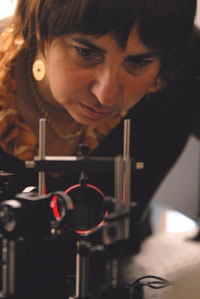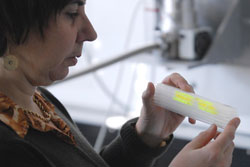
LEDs which produce white light could replace conventional light bulbs. Photo: Peter Grewer
Münster (upm), 14. Mai 2007

From an ecological point of view, photosynthesis is the most important photochemical reaction on our planet. It provides plants with the metabolistic energy they need to grow by converting sunlight into chemical energy. When light hits parts of the chlorophyll, electrons are put into an excited, energy-rich state and can thus, through a cascade of reactions, produce energy for vegetable metabolism. The systems which Prof. Luisa De Cola is researching with her team at the Centre for Nano-Technology (CeNTech) obey the same photochemical principles, even though they are designed for fundamentally different aims.
De Cola trained as chemist in Bologna. Together with twelve members of her team she moved from Amsterdam to CeNTech in mid-2005, where she took over the Chair of Physical Photochemistry and Photonic Materials at the Institute of Physics. The team has now grown to 20 members, for the most part chemists and a few physicists, and De Cola's teaching and research activities extend way beyond the Institute of Physics. In addition to her lectures for physicists, she is also involved in looking after PhD students in chemistry at the research training group. Her research projects are run in collaboration with teams from the Departments of Organic and Inorganic Biochemistry, from the Faculty of Medicine, with electrical engineers and representatives of industry. "I see myself as a pure chemist, although in the German university system I would probably be described rather as a physical chemist," is how De Cola describes her scientific roots, rolling her eyes a little as she speaks and showing her clear astonishment at the rigid allocation to institutes here. In her research career so far - in Italy, the USA and the Netherlands - she has not been used to this and wishes the university environment could be less rigid in Münster, too. "The reason I came to Münster from Amsterdam was the prospect of being able to work here at CeNTech with a large number of scientists from all fields of chemistry, physics and, above all, medicine."
Incidentally, De Cola says all this in fluent English. True, she can understand German due to its similarity to Dutch, but she cannot speak it. As there are four different nationalities in the team, English is spoken everywhere as the universal means of communication among scientists. "It's considered to be very important that in the team people speak English," is how Manuel Tsotsalas, one of the new PhD students in Münster, describes the working atmosphere. He likes the arrangement a lot. "It prevents cliques developing."
De Cola's field of research - photochemistry and photonic materials - offers ideal conditions for such cross-faculty collaboration. The basics of photonics, i.e. the generation, measurement or utilisation of light are rooted in physic, the synthesis of the molecules and materials with which the studies are carried out is purely chemical - while the application of the fundamentals being researched is at home in the fields of bio-medicine and electrical engineering.
In the synthesis of her materials she relies on the molecular self-arrangement of individual components into complex systems in accordance with the principles of supramolecular chemistry. "All other approaches, in which the components have to be added together step by step, require much too much time and effort," says De Cola. "In the material sciences in particular the trend is towards ever more complex molecular systems which have to be producible not only at laboratory scale but also on an industrial and economic scale. Supramolecular chemistry is a tool which allows such structures to be built up independently from their individual components."

All diode material can only produce light with a certain wavelength and colour. White light, however, results from the superimposition of a multitude of colours and contains a broad spectrum of wavelengths. Members of De Cola's team have therefore synthesised a complex molecule with an iridium nucleus which shines in an orange, green or blue light, as a result of slight changes in the chemical composition. The right combination of these three components produces white light. "Iridium is especially suitable for use in LEDs because it is a so-called triplet emitter," is how De Cola explains the quantum chemical details of her system. Triplet emitters are highly efficient and radiate an especially high amount of light during electronic excitement.
A further focus of research is the production and application of bio-compatible nano-particles for in-vivo imaging and for diagnostic purposes in the field of medicine. The main components of these nano-particles are zeolites - anorganic crystalline solids made of silicon and aluminium oxides, the main components of normal glass. A zeolite crystal can be imagined as a bundle of several parallel straws, except that these have been shortened to a length of around 30 nano-metres. Such a particle has several canals running in the same direction, each with an opening on each side.
Just as a snaplight can be pushed into one of the straws in the bundle, so luminescent pigments can be introduced through these openings into the canal-shaped cavities, where they are protected from "light-extinguishing" molecules such as oxygen. As a result, the lifetime of the marking substances enclosed is increased. The zeolites can also be used as a basis for better contrast agents in magnetic resonance imaging (MRI). Because of the tiny size and the chemical resistance of the nano-particles the researchers hope that injecting them into living tissue will not produce any defence reaction by the body. In order to find this out, De Cola is working closely with Prof. Christoph Bremer and Prof. Walter Heindel, radiologists at Münster University Clinic, as well as with partners from industry.
But although she is guided by possible applications of her research results, De Cola does not see herself as a nano-technologist or engineer. "We are nano-scientists - that goes way beyond the purely technological approach! Our aim is to study and examine general fundamental molecular mechanisms in nano-scale."
Because De Cola loves to collaborate with others and, as she puts it, thanks to this "wonderful university with its outstanding medical and scientific faculties", all Münster's resources are at her disposal. Nor does she have any worries about personnel in the future. She thinks Münster's students are highly intelligent, really bright. Optimum requirements, therefore, for researching white light.